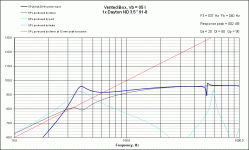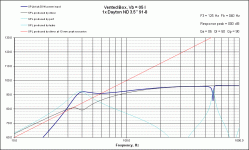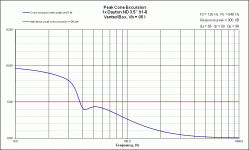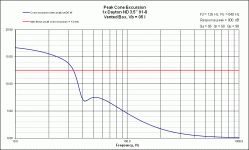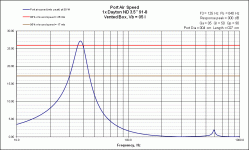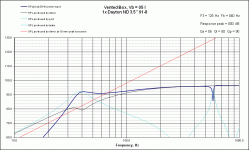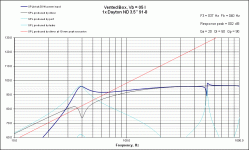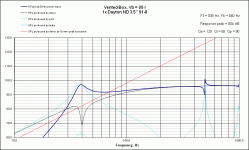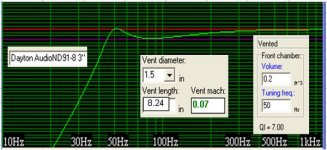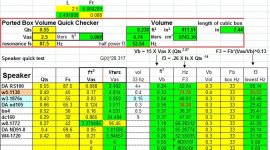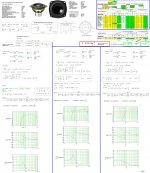Hey, I don't want to throw a wrench into your process but I thought it might be worth re-visiting your original design goals with a different driver.
The goals:
- smallest box possible, ie, 7" x 10" x 7.5" (interior), so Vb = 8.6L
- f3 ~= 40Hz
- max SPL ~= 90dB ?
- sound quality = very good but not the highest fidelity
So I've got 6 of these things I'm playing around with right now Dayton Audio ND91-8 3-1/2" Aluminum Cone Full-Range Driver 8 290-226 and I just finished a test box for 2 of them to run as a mini sub for a low SPL 5.1 system and quite frankly I'm gobsmacked.
They don't hit the lowest octave or so but in an EBS alignment (Extended Bass Shelf) with heavy stuffing, f4 is a solid 40Hz and I wasn't quite expecting that at all.
Here's what I'm doing:
Box = 4" x 10.5" x 8.5" (interior, but adjust dimensions to suit)
Vb = 5L, which doesn't include port, bracing and driver volume (that's smaller than what you were originally thinking)
Fb = 40Hz
Port = 3.5 x 27cm (1.4" x 13")
xmax on these is 5mm but the x-mechanical is a solid 12.5mm one way. That's a full inch of peak to peak excursion in a little 3 1/2" driver.
Similar to the TB W5 1138, port length gets a little long and you have to watch out again for port resonance and air speed but these are manageable.
Below are the graphs:
1. FR at 30W with the walls covered.
2. FR at 30W with heavy stuffing which takes care of the 40Hz peaking.
3. SPL limit of 87.5dB at xmax (above 40Hz) with 10W
4. SPL limit 92dB at xmech (above 40Hz) with 30W
5. port air speed at 30W
They call these full range but really, they need help in the high end so add a tweeter. Or xo below the port resonance frequency (which is a short steep null close to 600Hz, as apposed to a null and peak with the 1138 - so not quite so bad) to something like the little 2" Vifa or TB mid/tweeters.
Just a thought - these things really are quite impressive. And with the EBS alignment, just use the Bass control to bring the LF's up a couple of dB's for a flatter response. I think the grandkids will be amazed.
Could be what you're looking for....
The goals:
- smallest box possible, ie, 7" x 10" x 7.5" (interior), so Vb = 8.6L
- f3 ~= 40Hz
- max SPL ~= 90dB ?
- sound quality = very good but not the highest fidelity
So I've got 6 of these things I'm playing around with right now Dayton Audio ND91-8 3-1/2" Aluminum Cone Full-Range Driver 8 290-226 and I just finished a test box for 2 of them to run as a mini sub for a low SPL 5.1 system and quite frankly I'm gobsmacked.
They don't hit the lowest octave or so but in an EBS alignment (Extended Bass Shelf) with heavy stuffing, f4 is a solid 40Hz and I wasn't quite expecting that at all.
Here's what I'm doing:
Box = 4" x 10.5" x 8.5" (interior, but adjust dimensions to suit)
Vb = 5L, which doesn't include port, bracing and driver volume (that's smaller than what you were originally thinking)
Fb = 40Hz
Port = 3.5 x 27cm (1.4" x 13")
xmax on these is 5mm but the x-mechanical is a solid 12.5mm one way. That's a full inch of peak to peak excursion in a little 3 1/2" driver.
Similar to the TB W5 1138, port length gets a little long and you have to watch out again for port resonance and air speed but these are manageable.
Below are the graphs:
1. FR at 30W with the walls covered.
2. FR at 30W with heavy stuffing which takes care of the 40Hz peaking.
3. SPL limit of 87.5dB at xmax (above 40Hz) with 10W
4. SPL limit 92dB at xmech (above 40Hz) with 30W
5. port air speed at 30W
They call these full range but really, they need help in the high end so add a tweeter. Or xo below the port resonance frequency (which is a short steep null close to 600Hz, as apposed to a null and peak with the 1138 - so not quite so bad) to something like the little 2" Vifa or TB mid/tweeters.
Just a thought - these things really are quite impressive. And with the EBS alignment, just use the Bass control to bring the LF's up a couple of dB's for a flatter response. I think the grandkids will be amazed.
Could be what you're looking for....
Attachments
I didn't go back and compare, but I think that's quite similar to what you get with the proposed driver all the way back on the first page in the OP, is it not?
Well, I wasn't at all certain that these little drivers could actually achieve in reality what the sims suggest they can do on paper until now that I've put them in a box and tried them. Nor how good/bad they would sound. And I am frankly astonished.
I haven't heard the TB W3-1876S so I'm not certain what they can do, but the ND91-8 looks to have some advantages over them on paper.
8 ohm vs 4 ohm (if that makes a difference to your amp)
81 vs 76 dB sensitivity
twice the power handling
25mm xmech (peak to peak) vs ??
copper alloy shorting rings vs none?
So now that I have some personal experience with these drivers, they seemed worth mentioning and recommending. Then again, if the original goals aren't compromised too much then the TB W5 1138 may be the way for the OP to go.
Why heavy stuffing in a bass reflex mini sub? You'll get more bass without it.
This alignment can produce some (boomy?) peaking at the Fb. The stuffing tames it producing a smoother LF roll-off which in turn makes it more amenable to a little boosting with the bass tone control (which on my receiver is a 6dB gain starting at about 400/500Hz on down). I've left the area between the ports and drivers clear of course.
Graphs with no fill, walls covered and with heavy fill.
Attachments
In those graphs, the blue line is the summed response of the cone and the port. The cone's response (black line) stays below xmax above 40Hz.
Also what makes these drivers a little special is that their total linear excursion far exceeds their xmax. So you can push these quite a bit albeit with some extra distortion. That's the trade off. Unibox shows 87.5dB 1W 1M with excursion staying below xmax with signals above 40Hz. That's pretty loud. Still there's another 4.5dB of headroom before they max out their excursion limits.
The W5-1138 will definitely play louder within its xmax but the box will have to be at least a couple of litres bigger. Your choice of trade-offs.
Also what makes these drivers a little special is that their total linear excursion far exceeds their xmax. So you can push these quite a bit albeit with some extra distortion. That's the trade off. Unibox shows 87.5dB 1W 1M with excursion staying below xmax with signals above 40Hz. That's pretty loud. Still there's another 4.5dB of headroom before they max out their excursion limits.
The W5-1138 will definitely play louder within its xmax but the box will have to be at least a couple of litres bigger. Your choice of trade-offs.
Not a good speaker/box match.
Your box is too big for the speaker, you are tuned too low. Whenever you see the response curve dip down 3 dB above cutoff, then come back up at the tuning frequency, (Fb), then go back down, you usually have a large group delay. It will play but won't sound as good as a speaker matched for the box.
Also, at 5mm your linear excursion is about half of the TangBand, although you can drive the Dayton harder past it's linear excursion-it's maximum limit is 12mm.
Your box is too big for the speaker, you are tuned too low. Whenever you see the response curve dip down 3 dB above cutoff, then come back up at the tuning frequency, (Fb), then go back down, you usually have a large group delay. It will play but won't sound as good as a speaker matched for the box.
Also, at 5mm your linear excursion is about half of the TangBand, although you can drive the Dayton harder past it's linear excursion-it's maximum limit is 12mm.
fwbutler, I get pretty much the same response in .2 cubic ft when tuned to 50Hz using Unibox. I've got my test box tuned to 40Hz though and I'm measuring output to 35Hz but after that it drops like a stone. What I like about using Unibox is that it also includes the effects of different stuffing as well as the effects of port resonances.
kelticwizard, yes you've pretty much defined an EBS alignment. I am unaware of what is happening re group delay, but I'll repeat myself again and say that these ND91's sound remarkably good. They are certainly not up to the highest levels of audio reproduction but unless fwbutler's grandkids are budding audiophiles, I think these could very well meet their needs. In this situation, I think the kids would probably appreciate quantity over quality, but of course, I could be wrong.
So far, for a low SPL, low footprint bedroom system, I'm liking what these are doing in the low end and think the midrange is acceptable. The HF's on the other hand are definitely lacking. Still the TB 1138 will have an easier time staying below xmax, it just needs a bigger box to do it. But let's not kid ourselves here - virtually nothing under probably 8" can push out sub 80Hz frequencies with any degree of low distortion. That's a compromise that anything this small is always going to have to live with. Just rifle through a few of Zaph's driver distortion measurements to get a feel for that.
kelticwizard, yes you've pretty much defined an EBS alignment. I am unaware of what is happening re group delay, but I'll repeat myself again and say that these ND91's sound remarkably good. They are certainly not up to the highest levels of audio reproduction but unless fwbutler's grandkids are budding audiophiles, I think these could very well meet their needs. In this situation, I think the kids would probably appreciate quantity over quality, but of course, I could be wrong.
So far, for a low SPL, low footprint bedroom system, I'm liking what these are doing in the low end and think the midrange is acceptable. The HF's on the other hand are definitely lacking. Still the TB 1138 will have an easier time staying below xmax, it just needs a bigger box to do it. But let's not kid ourselves here - virtually nothing under probably 8" can push out sub 80Hz frequencies with any degree of low distortion. That's a compromise that anything this small is always going to have to live with. Just rifle through a few of Zaph's driver distortion measurements to get a feel for that.
fw,
any progress on this project? I have been considering the same project with the same bass driver for about a year but have not pulled the trigger. My box numbers came out the same for the bass section. .20 ft^3 tuned @ 44hz. I was however considering the new Fountek fr58ex crossed @ about 250 LR4 for the mid/tweet.
Fountek FR58EX 2" Neodymium Full Range Driver 296-725
any progress on this project? I have been considering the same project with the same bass driver for about a year but have not pulled the trigger. My box numbers came out the same for the bass section. .20 ft^3 tuned @ 44hz. I was however considering the new Fountek fr58ex crossed @ about 250 LR4 for the mid/tweet.
Fountek FR58EX 2" Neodymium Full Range Driver 296-725
I really like the looks of the 58ex specs and graph. It needs very little box room as well. My concerns though with that driver are (1) the fact that there is no off axis response curves (as with all Fountek drivers) and (2) is it robust enough to go down to 100-200 Hz with decent distortion if the cross point is that low. I think the key here is for me buy a couple and test them. $40 isn't much of a risk.
I don't know if you're still working on this and I didn't read the last few pages, but I did read the first 4-5.
I must say it sounds like you're struggling and you probably will not be pleased with the results because you're trying to fight the laws of good speaker design.
Why aren't you just considering a normal TM with good bass response? The Tang Band driver that you like clearly states that it's a subwoofer and trying to shoehorn that into a typical two-way probably either isn't going to work or is going to be very difficult. Also, with your budget of $50ish you may have trouble finding a tweeter that will cross that low. BTW, the Vifa DX25 is only $19 right now and I think it can get down to 1500Hz, not LR2 though as you're looking for.
I saw people mentioning a fast and that sounds like a better idea. You could look at the Aura the Linkwitz uses in the Pluto. There is also a 1" version of that that probably would need and even smaller enclosure.
If it were me though I would look at Dumptruck's recommendation from post #3-the Speedsters. Small, great bass and can hit 100db. If they're too expensive you could look at a couple of other of Paul C's designs like the Classix II or the Hitmakers. I think any of those is going to get you about as much bass as can be had from boxes of those sizes. Trying to get to 30Hz in under 10L just isn't going to happen, at least not at any volume, but that goal really isn't necessary. Strong 50Hz output should be fine for your grandkids, plus a subwoofer woofer would be a nice second project down the road and maybe you could build it together.
Evan
I must say it sounds like you're struggling and you probably will not be pleased with the results because you're trying to fight the laws of good speaker design.
Why aren't you just considering a normal TM with good bass response? The Tang Band driver that you like clearly states that it's a subwoofer and trying to shoehorn that into a typical two-way probably either isn't going to work or is going to be very difficult. Also, with your budget of $50ish you may have trouble finding a tweeter that will cross that low. BTW, the Vifa DX25 is only $19 right now and I think it can get down to 1500Hz, not LR2 though as you're looking for.
I saw people mentioning a fast and that sounds like a better idea. You could look at the Aura the Linkwitz uses in the Pluto. There is also a 1" version of that that probably would need and even smaller enclosure.
If it were me though I would look at Dumptruck's recommendation from post #3-the Speedsters. Small, great bass and can hit 100db. If they're too expensive you could look at a couple of other of Paul C's designs like the Classix II or the Hitmakers. I think any of those is going to get you about as much bass as can be had from boxes of those sizes. Trying to get to 30Hz in under 10L just isn't going to happen, at least not at any volume, but that goal really isn't necessary. Strong 50Hz output should be fine for your grandkids, plus a subwoofer woofer would be a nice second project down the road and maybe you could build it together.
Evan
Thanks.
You guys have given me a lot to think about and work on. This project started with the four limits; freq range, cost, sound quality, size. Other speakers projects have easily achieved two or three of the goals by compromising the other one or two. By lots of research and the help I receive from you-all I am getting closer to getting all four.
As a Physicist I do not want to ignore the rules of the physics of sound, and materials science. I want to use them to stretch what the right small speaker can be made to do in the correctly designed enclosure.
You guys have given me a lot to think about and work on. This project started with the four limits; freq range, cost, sound quality, size. Other speakers projects have easily achieved two or three of the goals by compromising the other one or two. By lots of research and the help I receive from you-all I am getting closer to getting all four.
As a Physicist I do not want to ignore the rules of the physics of sound, and materials science. I want to use them to stretch what the right small speaker can be made to do in the correctly designed enclosure.
Thanks.
You guys have given me a lot to think about and work on. This project started with the four limits; freq range, cost, sound quality, size. Other speakers projects have easily achieved two or three of the goals by compromising the other one or two. By lots of research and the help I receive from you-all I am getting closer to getting all four.
As a Physicist I do not want to ignore the rules of the physics of sound, and materials science. I want to use them to stretch what the right small speaker can be made to do in the correctly designed enclosure.
No problem. I'm not trying to rain on your parade. Most people will recommend that you build a preexisting design and I think it's a good idea, but if you want to design a speaker then I say go for it.
As for a woofer that can play low in a small box, has a good midrange quality and an easy to work with response, take a look at the Tang Band W4-1720. It models with an f3 in the mid to low 40's in only about 6L and remember that with room gain you should easily be getting into the 30's. It's sometimes on sale for around $35. Cross to that DX25 I mentioned or a small neo around 3K and you should have a very nice little speaker.
Also, for a cheaper option, maybe the Dayton DC160-08. I've used the 4ohm version in small sub woofers with surprising results. The 8ohm is easy to work with and has a nice sound to it.
Good luck
I changed computers so do not have all my evaluation software up at the moment. However here is a quick check of a very few drivers that I have evaluated. Based on vol and F3 there are some better but it was a good idea and deserves a full evaluation. The shape of the Freq Res curve will tell a lot.
Attachments
Last edited:
I changed computers so do not have all my evaluation software up at the moment. However here is a quick check of a very few drivers that I have evaluated. Based on vol and F3 there are some better but it was a good idea and deserves a full evaluation. The shape of the Freq Res curve will tell a lot.
I'm not completely sure how to interpret this; what program is this? What does the volume column stand for? I'm not familiar with all of these, but looking at the two that I recommended, you should be able to get nice curves with an f3 that's quite a bit lower than what is shown here.
If you have a program like unibox or winisd it's helpful to be able to see the kind of curve you can expect, in conjunction with max SPL as it relates to cone excursion.
I noticed the ND91, that's a good one for extension, I believe that the Aura version has a smoother response though. Just remember that a driver that small will not move a lot of air, which is required for good low bass. Another one to look at in that series they may work better for you is the ND105. BTW, all of the ND series are on sale right now.
I changed computers so do not have all my evaluation software up at the moment. However here is a quick check of a very few drivers that I have evaluated. Based on vol and F3 there are some better but it was a good idea and deserves a full evaluation. The shape of the Freq Res curve will tell a lot.
Hi fwbuttler, All,
FYI:
An example of how to sort the suitability of small Drivers.
Only the Volume requirement are calculated for Drivers ( Here only exemplified by using the Dayton-Audio-ND91-8 Driver) in Boxes with Qts equal or lower than 0.5 that do not return an equivalent Qt of less than 0.5 or more than 0.707(Max 1 dB Peaking).
b
PS: Check your Speaker quick test spreadsheet for errors.
Attachments
- Status
- This old topic is closed. If you want to reopen this topic, contact a moderator using the "Report Post" button.
- Home
- Loudspeakers
- Multi-Way
- 30 HZ from a 10 X 7 box
